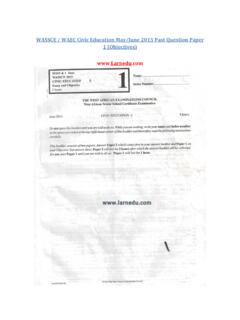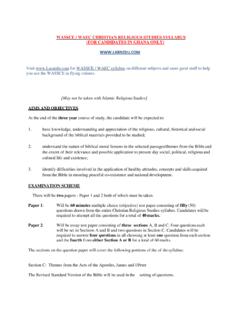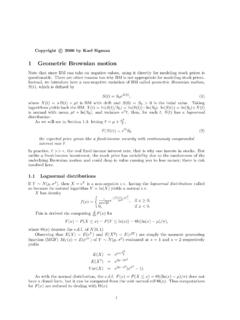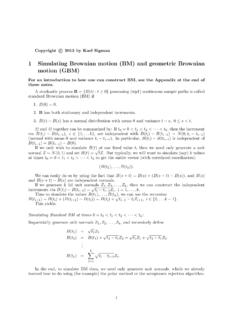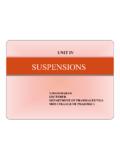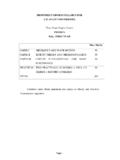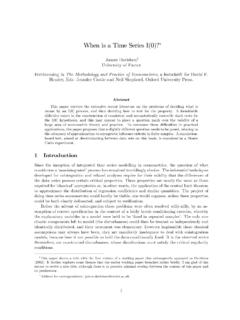Transcription of WASSCE / WAEC Physics Syllabus - Larnedu.com
1 1 WASSCE / waec Physics Syllabus Visit for WASSCE / waec Syllabus on different subjects and more great stuff to help you ace the WASSCE in flying colours. PREAMBLE The Syllabus is evolved from the Senior Secondary School teaching Syllabus and is intended to indicate the scope of the course for Physics examination. It is structured with the conceptual approach. The broad concepts of Matter, Position, Motion and Time; Energy; Waves; Fields; Atomic and Nuclear Physics , Electronics are considered and each concept forms a part on which other sub-concepts are further based. AIMS The aims of the Syllabus are to enable candidates: (1) acquire proper understanding of the basic principles and applications of Physics ; (2) develop scientific skills and attitudes as pre-requisites for further scientific activities; (3) recognize the usefulness, and limitations of scientific method to appreciate its applicability ion other disciplines and in every life; (4) develop abilities, attitudes and skills that encourage efficient and safe practice; (5) develop scientific attitudes such as accuracy, precision, objectivity, integrity, initiative and inventiveness.
2 ASSESSMENT OBJECTIVES The following activities appropriate to Physics will be tested: (1) Acquisition of knowledge and understanding: Candidates should be able to demonstrate knowledge and understanding of; 2 (a) Scientific phenomena, facts laws, definitions, concepts and theories; (b) Scientific vocabulary, terminology and conventions (including symbols, quantities and units); (c) The use of scientific apparatus, including techniques of operation and aspects of safety; (d) Scientific quantities and their determinations; (e) Scientific and technological applications with their social economic and environmental implications. 3 (2) Information Handling and Problem-solving Candidates should be able, using visual, oral, aural and written (including symbolic, diagrammatic, graphical and numerical) information to: (a) locate select, organize and present information from a variety of sources including everyday experience; (b) Analyse and evaluate information and other data; (c) Use information to identify patterns, report trends and draw inferences; (d) Present reasonable explanations for natural occurrences, patterns and relationships; (e) Make predictions from data.
3 (3) Experimental and Problem-Solving Techniques Candidates should be able to: (a) Follow instructions; (b) Carry out experimental procedures using apparatus; (c) Make and record observations, measurements and estimates with due regard to precision, accuracy and units; (d) Interpret, evaluate and report on observations and experimental data; (e) Identify problems, plan and carry out investigations, including the selection of techniques, apparatus, measuring devices and materials; (f) Evaluate methods and suggest possible improvements; (g) State and explain the necessary precautions taken in experiments to obtain accurate results. SCHEME OF EXAMINATION There will be three papers, Papers 1, 2 and 3, all of which must be taken. Papers 1 and 2 will be a composite paper to be taken at one sitting. PAPER 1: Will consist of fifty multiple choice questions lasting 1 hours and carrying 50 marks.
4 PAPER 2: Will consist of two sections, Sections A and B, both lasting for 1 hours and carrying 60 marks. Section A - Will comprise seven short-structured questions. Candidates will be required to answer any five questions for a total of 15 marks. Section B - Will comprise five essay questions out of which candidates will be required to answer any three for 45 marks. 4 PAPER 3: Will be a practical test for school candidates or a test of practical work for private candidates. Each version of the paper will comprise three questions out of which candidates will be required to answer any two in 2 hours for 50 marks. Candidates taking the practical test will be allowed additional 15 minutes for reading the paper during which time they are not expected to do any writing. PRACTICAL Physics This will be tested by a practical examination based on the Syllabus .
5 The objective of the practical examination is to test how well the candidates understand the nature of scientific investigation and their capability in handling simple apparatus in an experiment to determine an answer to a practical question. It is also to determine their competence in demonstrating their understanding of some of the principles involved in a small-scale laboratory experiment. The practical test will contain enough instructions to enable candidates to carry out the experiment. Even when standard experiments, such as the determination of focal lengths or specific heat capacities are set, candidates will be told what readings to take and how to arrive at the result. Therefore, it should not be necessary for candidates to learn by heart how to perform any experiment. In addition to experiments on the topics in the Syllabus , candidates may be asked to carry out with the aid of full instructions, variants of standard experiments.
6 Candidates should be trained to take as varied a set of readings as possible and to set out the actual observed readings systematically on the answer sheet. The experiments may require a repetition of readings and an exhibition of results graphically and their interpretation. DETAILED Syllabus It is important that candidates are involved in practical activities in covering this Syllabus . Candidates will be expected to answer questions on the topics set in the column headed TOPIC . The NOTES are intended to indicate the scope of the questions which will be set but they are not to be considered as an exhaustive list of limitations and illustrations. NOTE: Questions will be set in units. However, multiples or sub-multiples of the units may be used. PART 1 INTERACTION OF MATTER, SPACE & TIME TOPICS NOTES 1. Concepts of matter Simple structure of matter should be discussed.
7 Three Physics states of matter, namely solid, 5 2. Fundamental and derived quantities and units (a) Fundamental quantities and units (b) Derived quantities and units 3. Position, distance and displacement. (a) ) Concept of position as a location of point-rectangular coordinates. (b) Measurement of distance (c) ) Concept of direction as a way of locating a point bearing (d) Distinction between distance and displacement. liquid and gas should be treated. Evidence of the particle nature of matter Brownian motion experiment, Kinetic theory of matter. Use of the theory to explain; states of matter (solid, liquid and gas), pressure in a gas, evaporation and boiling; cohesion, adhesion, capillarity. Crystalline and amorphous substances to be compared (Arrangement of atoms in crystalline structure to be described face centred, body centred.
8 Length, mass, time, electric current luminous intensity, thermodynamic temperature, amount of substance as examples of fundamental quantities and m, kg, s, A, cd, K and mol as their respective units. Volume, density and speed as derived quantities and m3, kgm-3 and ms-1 as their respective units. Position of objects in space using the X,Y,Z axes should be mentioned. Use of string, metre rule, vernier calipers and micrometer screw gauge. Degree of accuracy should be noted. Metre (m) as unit of distance. Use of compass and a protractor. Graphical location and directions by axes to be stressed. TOPICS NOTES 4. Mass and weight Distinction between mass and weight 5. Time (a) ) Concept of time as interval between physical events Use of lever balance and chemical/beam balance to measure mass and spring balance to measure weight.
9 Mention should be made of electronic/digital balance. Kilogram (kg) as unit of mass and newton (N) as unit of weight. The use of heart-beat, sand-clock, ticker-timer, pendulum and stopwatch/clock. 6 (b) Measurement of time 6. Fluid at rest (a) Volume, density and relative density (b) Pressure in fluids (c) Equilibrium of bodies (i) Archimedes principle (ii) Law of flotation Second(s) as unit of time. Experimental determination for solids and liquids. Concept and definition of pressure. Pascal s principle, application of principle to hydraulic press and car brakes. Dependence of pressure on the depth of a point below a liquid surface. Atmospheric pressure. Simple barometer, manometer, siphon, syringe and pump. Determination of the relative density of liquids with U-tube and Hare s apparatus. Identification of the forces acting on a body partially or completely immersed in a fluid.
10 Use of the principle to determine the relative densities of solids and liquids. Establishing the conditions for a body to float in a fluid. Applications in hydrometer, balloons, boats, ships, submarines etc. TOPICS NOTES 7. Motion (a) Types of motion: Random, rectilinear, translational, Rotational, circular, orbital, spin, Oscillatory. (b) Relative motion (c) Cause of motion (d) Types of force: (i) Contact force (ii) Non-contact force(field force) (e) Solid friction Only qualitative treatment is required. Illustration should be given for the various types of motion. Numerical problems on co-linear motion may be set. Force as cause of motion. Push and pull These are field forces namely; electric and magnetic attractions and repulsions; gravitational pull. Frictional force between two stationary bodies (static) and between two bodies in relative motion 7 (f) Viscosity (friction in fluids) (g) Simple ideas of circular motion (dynamic).
